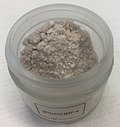Diazonium compound
(Redirected from Diazotization)
Diazonium compounds are a group of organic compounds sharing a common functional group R-N_2^+ where R can be any organic residue, and N_2^+ represents the diazonium group. These compounds are characterized by the presence of a nitrogen doublet (N_2^+) which is positively charged. Diazonium compounds play a crucial role in organic synthesis, especially in the preparation of azo dyes, and are also used in the modification of polymers and in the synthesis of aromatic compounds through processes such as Sandmeyer reaction and Gomberg–Bachmann reaction.
Structure and Bonding
The diazonium group consists of two nitrogen atoms, with one of the nitrogens bearing a positive charge and the other nitrogen atom having a lone pair of electrons. This configuration leads to a linear structure around the nitrogen-nitrogen bond. The positive charge on the nitrogen is stabilized by resonance with adjacent pi systems or lone pairs on the substituent R group, if present.
Preparation
Diazonium compounds are typically prepared from primary aromatic amines through a process known as diazotization. This process involves treating the amine with nitrous acid (HNO_2), which is often generated in situ from sodium nitrite (NaNO_2) and a mineral acid like hydrochloric acid (HCl). The reaction temperature is kept low to prevent decomposition of the diazonium compound.
Reactions
Diazonium compounds are highly reactive and can participate in a variety of reactions. Some of the most important reactions include:
- Coupling Reactions: Diazonium compounds can react with electron-rich aromatic compounds to form azo compounds, which are characterized by their vivid colors and are used in dyeing fabrics.
- Sandmeyer Reaction: This reaction involves the replacement of the diazonium group with a halogen, cyanide, or other groups, facilitated by copper(I) salts.
- Gomberg–Bachmann Reaction: A method for producing biaryls through the reaction of diazonium salts with aromatic compounds in the presence of base.
- Decomposition: Diazonium compounds can decompose to form carbocations, which can then undergo further reactions such as rearrangements or coupling with nucleophiles.
Safety
Diazonium compounds can be explosive, especially when dry or concentrated. They require careful handling, usually at low temperatures, and in dilute solutions to minimize the risk of detonation. Their use is typically restricted to the laboratory under controlled conditions.
Applications
The primary application of diazonium compounds is in the synthesis of azo dyes, which are used extensively in the textile industry. They are also used in the production of various organic compounds, including pharmaceuticals and agrochemicals, through synthetic transformations that involve the diazonium functional group.
See Also
Diazonium_compound
Transform your life with W8MD's budget GLP-1 injections from $125.
W8MD offers a medical weight loss program to lose weight in Philadelphia. Our physician-supervised medical weight loss provides:
- Most insurances accepted or discounted self-pay rates. We will obtain insurance prior authorizations if needed.
- Generic GLP1 weight loss injections from $125 for the starting dose.
- Also offer prescription weight loss medications including Phentermine, Qsymia, Diethylpropion, Contrave etc.
NYC weight loss doctor appointments
Start your NYC weight loss journey today at our NYC medical weight loss and Philadelphia medical weight loss clinics.
- Call 718-946-5500 to lose weight in NYC or for medical weight loss in Philadelphia 215-676-2334.
- Tags:NYC medical weight loss, Philadelphia lose weight Zepbound NYC, Budget GLP1 weight loss injections, Wegovy Philadelphia, Wegovy NYC, Philadelphia medical weight loss, Brookly weight loss and Wegovy NYC
|
WikiMD's Wellness Encyclopedia |
| Let Food Be Thy Medicine Medicine Thy Food - Hippocrates |
Medical Disclaimer: WikiMD is not a substitute for professional medical advice. The information on WikiMD is provided as an information resource only, may be incorrect, outdated or misleading, and is not to be used or relied on for any diagnostic or treatment purposes. Please consult your health care provider before making any healthcare decisions or for guidance about a specific medical condition. WikiMD expressly disclaims responsibility, and shall have no liability, for any damages, loss, injury, or liability whatsoever suffered as a result of your reliance on the information contained in this site. By visiting this site you agree to the foregoing terms and conditions, which may from time to time be changed or supplemented by WikiMD. If you do not agree to the foregoing terms and conditions, you should not enter or use this site. See full disclaimer.
Credits:Most images are courtesy of Wikimedia commons, and templates, categories Wikipedia, licensed under CC BY SA or similar.
Contributors: Prab R. Tumpati, MD


